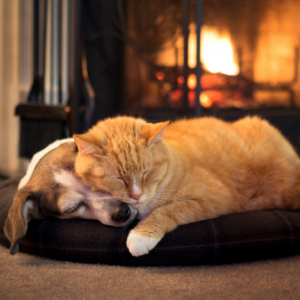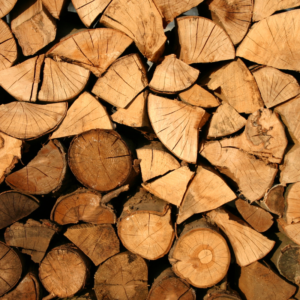Settling down in front of the fireplace with a good book or good friends? There’s nothing much more inviting when the weather gets chilly than the pleasant warmth and soft flicker of a fire.
As the days get chillier, be sure your fireplace is up to the task of keeping your home warmer and more comfortable through it all by reviewing some of our fireplace safety tips.
✓ Don’t Leave a Fire Unsupervised
 Before leaving home or heading to bed, be sure that your fire is completely out. A fire should never be left unattended or left burning while you’re sleeping. If you step out of the room and your fireplace is still hot, but sure to take young children and pets with you. Remain mindful that the fireplace stays dangerously hot for a while after the flames stop flickering.
Before leaving home or heading to bed, be sure that your fire is completely out. A fire should never be left unattended or left burning while you’re sleeping. If you step out of the room and your fireplace is still hot, but sure to take young children and pets with you. Remain mindful that the fireplace stays dangerously hot for a while after the flames stop flickering.
Also, remember to install smoke alarms on every level of your home, outside sleeping areas, and in each bedroom. Like your carbon monoxide detectors, these should be tested monthly and have their batteries replaced if they fail or once every year – whichever comes first.
✓ Maintain Proper Clearances
Yes, it’s inviting – but give your fire its space. Keep furniture and decorations clear of your fireplace by at least 36 inches. (This includes your potentially combustible holiday decor.) That Christmas tree or garland will look just as festive a few inches further away! Be sure anything outside the proper clearance is secure and not at risk of dangling too near the fire.
Kindling and other fire starters aren’t exempt from this rule. We tend to associate these with our fireplace, so we want to keep them close at hand. But be sure to store kindling far enough away that a stray spark can’t catch and ignite it outside the fireplace.
✓ Keep Ventilation in Mind
Ensure that your damper is open and flue is clear before starting a fire, and keep the damper open until your fire is completely out. This will draw smoke out of your home. Be aware that buildup of creosote and soot can keep the damper from properly opening and closing, so check it and the flue regularly.
Additionally, since carbon monoxide is colorless, odorless, and has the potential to be lethal, be sure to have correctly placed carbon monoxide detectors, and test them regularly.
✓ Invest in Chimney Inspections (& Follow Up With Recommendations)
Don’t build that first fire of the season until you’ve had your annual chimney inspection. Because weathering and damage can occur year-round, you may have issues that require attention. An inspection by a certified chimney sweep will give the expert the opportunity to spot small issues before they become big ones.
As with most types of home maintenance, issues addressed earlier are likely to be less costly to repair. With chimneys that are used and enjoyed, soot and creosote can build up and become increasingly difficult to remove with time. The sooner (and more regularly) it’s cleared out the more efficiently your system will run and the less risks your household will face.
But even if you haven’t used your chimney in a while, leaves and debris can create blockages and weather extremes can create wear and damage. Don’t neglect your inspection or procrastinate in dealing with any maintenance needs it identifies. Thankfully, our trusted professionals can add a measure of assurance and ease to this process!
✓ Use the Right Tools
Don’t handle the hot stuff! Use appropriate tools when tending a fire. This applies not only to burning logs, but doors or screens that have become hot. Even a quick adjustment with a makeshift ‘tool’ not suitable for fireplace use or a bare hand that’s too close to the fireplace can lead to injury.
Are you scooping out ash? Be sure to use a metal scoop to transfer the ash to a metal buck (with a lid). Then, keep the ash bucket stored on a non-flammable floor, like cement or brick, outside the home.
Also, be vigilant about sparks that can escape when adjusting the fire. Consider using a nonflammable rug, which can protect your flooring from stray sparks.
✓ Burn Only Well-Seasoned Firewood
 You light a fire for comfort and enjoyment. Burning anything other than seasoned firewood in your fireplace, then, is counter-productive, since it can lead to unpleasant – or downright hazardous – results. Treated wood, construction scraps, packaging – really, anything except seasoned wood – can release toxic chemicals and black smoke into your living space as they burn.
You light a fire for comfort and enjoyment. Burning anything other than seasoned firewood in your fireplace, then, is counter-productive, since it can lead to unpleasant – or downright hazardous – results. Treated wood, construction scraps, packaging – really, anything except seasoned wood – can release toxic chemicals and black smoke into your living space as they burn.
Your goal is a hot, clean, controlled burn. If you burn something other than firewood, use accelerants, or use green (freshly cut) wood, this goal won’t be achieved.
Your firewood should bear the marks of proper seasoning: visible splits and cracks, dark ends, and a relatively low weight. These are indicators that your wood is well seasoned, meaning it’s been dried long enough to reduce its water content – and it will burn cleanly.
✓ Keep It Clear
In addition to being inspected annually, your chimney should have a chimney cap to keep it clear of any accumulated organic matter and animals – twigs and leaves, nests, racoons, squirrels, birds, etc. – any of which can obstruct the flue gases from leaving your chimney, jam up the damper, and become fire hazards.
Be sure to also clear ash from the fireplace at times. A small layer of ash can be helpful during the burning season, as it can insulate coals and protect your firebox floor. But more than an inch can reduce airflow to your logs and generate a smokier fire.
Partner With Us in All Things Chimney
Daydreaming about a cozy addition to your home? To build your dream fireplace, or have an existing one swept, inspected, or repaired, don’t hesitate to reach out. We’re CSIA certified, experienced in our field, and strive to live up to our name – serving you with integrity every step of the way.
Call us at 570-221-4113 or reach out online now.

Recent Comments